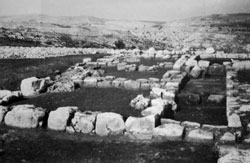
Pantalica (province of Syracuse)
Pantalica is the most conspicuous of the towns that flourished in Sicily in the Late Bronze Age and Early Iron Age. It is situated some twenty kilometres inland from Syracuse. The archaeological exploration of Pantalica was largely due to Paolo Orsi (1889-1897). Luigi Bernaḅ Brea conducted excavations especially in the area of the anaktoron between 1957 and 1971. The indigenous site of Pantalica can perhaps be identified with the ancient Hybla, whose king Hyblon permitted the Megarean colonists under their leader Lamis to found the Greek colony of Megara Hyblaea in a marginal area of his territory. The prehistoric settlement occupied an isolated rocky outcrop, surrounded all round by high cliffs, in large part inaccessible, that drop sheer to the river Anapo and its tributary Calcinara. Only the narrow saddle of Filiporto joins it to the plateau behind. So it was a real natural fortress.
At the centre of upland plateau, in an isolated position, stood the king's residence in megalithic structure (anaktoron), which is reminiscent in miniature of Mycenaean palaces and which also bears the traces of having been reused during the Byzantine period. The building, excavated by Orsi who also found the remains of a bronze foundry on the site, was subjected to an important study by Bernaḅ Brea. Countless artificial cave-tombs are concentrated on the rocky crags surrounding the town. Orsi counted some 5000 of them. They date between the 13th and 7th century BC. The grave goods found in these burials provide the basis for the chronology of the cultures of eastern Sicily between the late Bronze Age and the early Iron Age, as defined by L. Bernaḅ Brea on the basis of Orsi's periodization.
Bibliography:
- P. Orsi, Pantalica e Cassibile, in Monumenti Antichi dei Lincei, IX, 1899. col. 34 e segg.
- L. Bernabò Brea, Pantalica. Ricerche intorno all'anáktoron in Cahiers du Centre Jean Bérard, XIV, Centre Jean Bérard - Istituto Studi Acrensi, Naples- Palazzolo Acreide, 1990, pp. 1-110.
